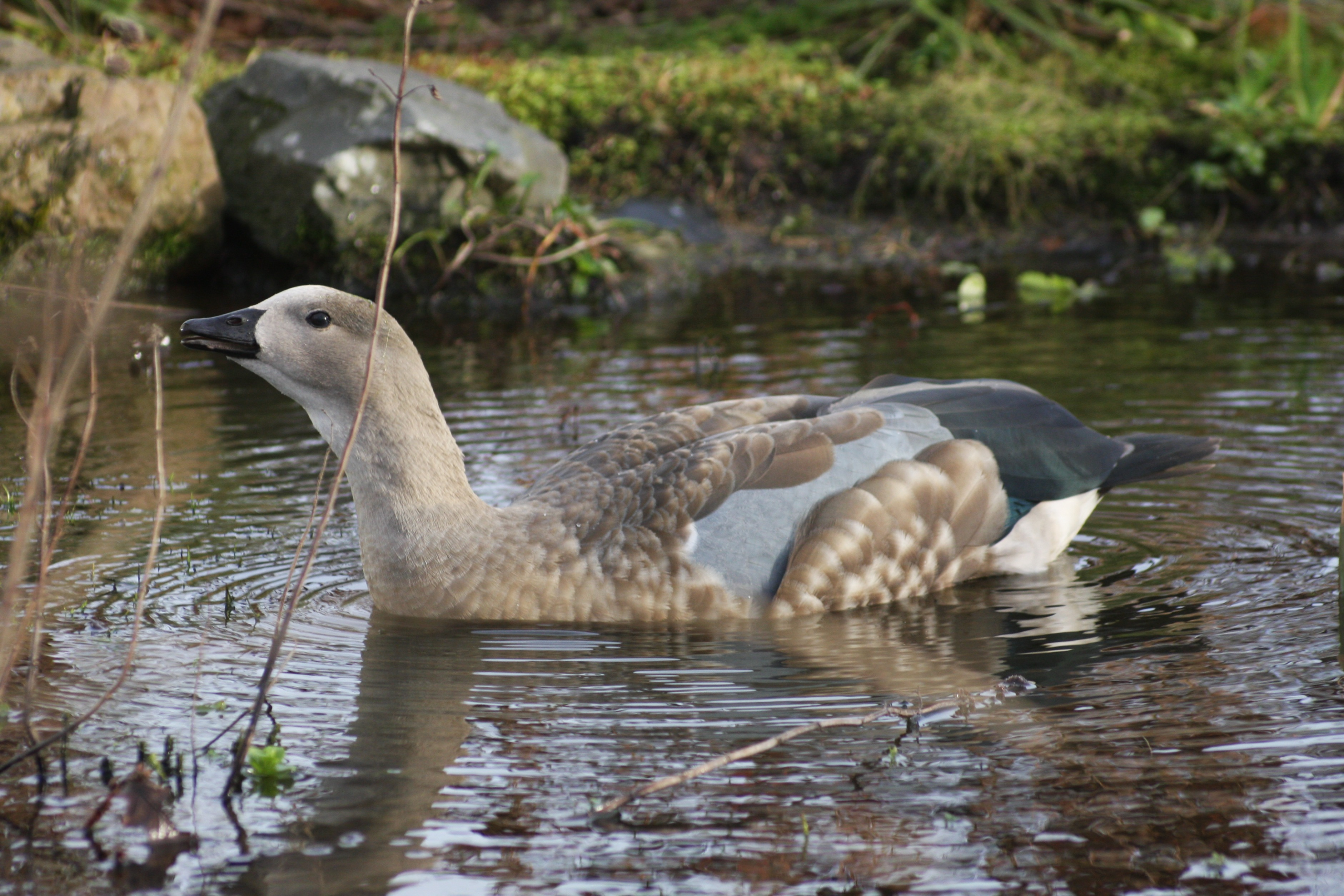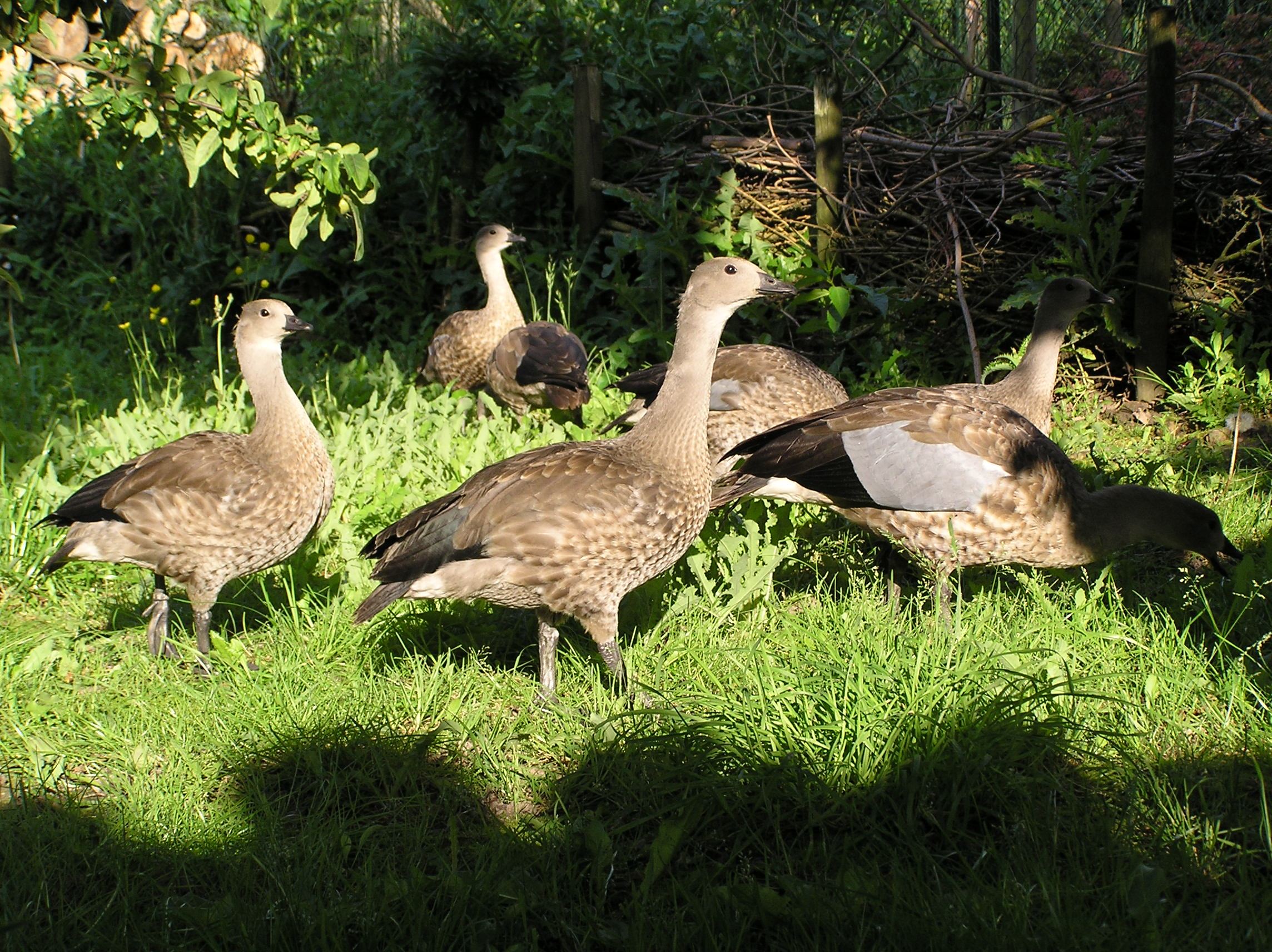Blue-winged goose
Cyanochen cyanoptera


Above: Blue-winged goose, male (Jan Harteman)
The blue-winged goose is an odd ball in the family of Anatidae (ducks, geese and swans). It is the only species within the genus of Cyanochen and its home range is only restricted to the Highlands of Ethiopia where it fourages on grassy meadows and pastures above 1400 meters, more usually above 2100 meters, adjacent to rivers, lakes and pools.
The blue-winged goose is listed as Near Threatened on the IUCN Red List of Threatened Species. It is still considered locally common within its very restricted range, with overall population most recently estimated by BirdLife International at 3300–10,000 mature individuals, but is considered to be declining in response to drainage and conversion of suitable breeding areas.
Approximately sixty birds are kept within zoological institutions worldwide (2025, ZIMS). The European zoological population (>40 birds) is managed by the European Association of Zoos and Aquaria (EAZA).
Blue-winged geese from a personal perspective
(by Jan Harteman, published in Aviornis International, April 2016)
Blue-winged geese aren't often kept in avicultural collections, both private and public. Currently, I know few breeders of this rather special and beautiful goose species. But why is the species so unpopular? Are they too unknown? I hope this story will change that.
I acquired my first pair in 2002. However, due to the preventative evacuation of all my birds in the spring of 2003, I lost them due to measures against bird flu. A real false start!
From 2003 to 2008, I thoroughly enjoyed a magnificent pair of blue-winged geese. It's been a while since they've been around my parents' house, but I have very fond memories of them. If the opportunity arises, I would gladly acquire them again. So, you can safely consider the experience I describe here as a recommendation, as long as you follow a few house rules for the blue-winged goose.
In 2003, I purchased a young pair from Peter Kooij in 't Zand. At home, the pair was placed in a pen measuring approximately 15 x 10 meters with a shallow pond (40 cm) measuring about 3 x 3 meters. A deeper pond is also possible, but in that case, ensure there is a shallow bank so the female can stand on the bottom with her feet during mating. Initially, there were no other inhabitants in the pen, as the Blue-winged Goose is a territorial species that is best kept separate from all other waterfowl.
Outside the breeding season, a pair sometimes seems to interact peacefully with other geese, but as soon as they feel the need to establish their own territory, the female will provoke the male to the point that he makes life difficult for all other waterfowl, or preferably kills them. Incidentally, my breeding pair was exceptionally tolerant of chickens, which also roamed the same pen without any problems during the breeding season. When I tried to release ducks in the same enclosure outside the breeding season, I had to intervene quickly because the male goose immediately attacked the ducks.
Blue-winged geese originate from the Ethiopian highlands and are therefore quite hardy to our winters. Although a frost-free night shelter was always available, the geese never used it. They preferred to swim in the pond, which remained ice-free due to the relatively high temperature of the pumped groundwater.
The enclosure was planted with various shrubs and some fruit trees, such as plums. Under one of the shrubs, an old oil barrel lay on its side, partially buried with a layer of soil. During the breeding season, this barrel was covered with a thick layer of straw for the birds to nest in. I also had two wooden cages in the enclosure so the birds could always choose where to nest. They appreciated this, as the nest was built in a different location each year.
I fed them daily maintenance pellets for waterfowl (Anseres from Kasper Faunafood) and a handful of mixed grains to keep them docile. They really enjoy the latter, but I preferred not to give them too much to prevent obesity. In early spring, I added an extruded (and therefore floating) waterfowl pellet containing 24% crude protein to their diet to stimulate their breeding instincts.
Because the grass in the enclosure stopped growing over time (they love it, and it grows too slowly in winter), I let the geese roam around the house on the lawn almost daily. This wasn't a problem at all, as the geese were remarkably docile. Because the entire garden is fenced in with goose-proof fencing, the geese were allowed to use the entire yard when I was home, so I could always keep an eye on them. They're definitely not nest-bound, so letting them roam freely, like chickens do, isn't possible.
I remember them calmly waddling along the patio, tapping their beaks on the window, or floating surreptitiously in the ornamental pond by the house. This didn't cause any problems when our dog was running around; the animals tolerated each other perfectly. Even when the pair with chicks were roaming around, they could use the entire garden at appropriate times. Given the available space, they preferred to wander around the block rather than try to chase us away. The only times they were a nuisance was when you got too close to the nest during the breeding season. In practice, this meant the entire garden was practically impassable.
In April 2006, six eggs were laid for the first time, and five chicks were born in May, all of which were raised exemplarily by their parents. In April 2007, a month earlier than the previous year, six chicks were born, five of which grew into beautiful geese. It seemed like the geese wanted to start breeding earlier every year, because in 2008, Madame was already brooding on February 26th, resulting in chicks in March. Unfortunately, this time only one chick was born, which died after just a few days. I hoped the pair would start a second clutch, but that wasn't the case.
Since I had made new plans for the blue-winged goose enclosure in the meantime, I decided to trade the pair in at the end of 2008 for a new challenge: red-breasted geese, which I've always had a soft spot for. Since then, I haven't had any blue-winged geese myself, but when I see them walking or swimming elsewhere, I always think back fondly to my beautiful pair, which I enjoyed for five years.

Above: Adult male blue-winged goose (Jan Harteman)

Above: Blue-winged goose in mixed exhibit with Gelada (baboons) at Rotterdam Zoo, the Netherlands (Jan Harteman, 2024).

Above: Blue-winged geese in mixed exhibit with Gelada (baboons) at Rotterdam Zoo, the Netherlands (Jan Harteman, 2024).

Above: a family of blue-winged geese in our collection (Jan Harteman)

Above: blue-winged gosling, only a few days old (Jan Harteman).

Above: a pair of blue-winged geese, male left (Jan Harteman)

Above: adult pair; male left, female right (Jan Harteman).








